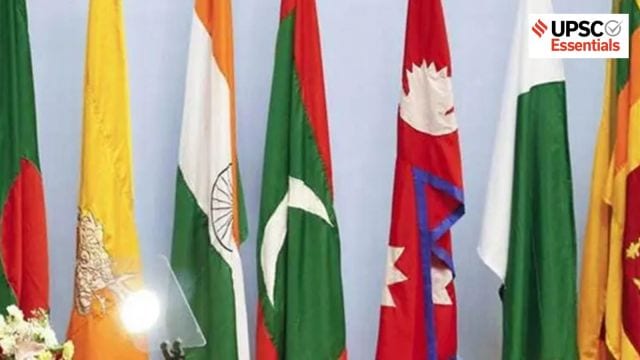© IE Online Media Services Pvt Ltd
Latest Comment
Post Comment
Read Comments
 The last SAARC summit (18th Summit) was convened in 2014 in Kathmandu (Representational)
The last SAARC summit (18th Summit) was convened in 2014 in Kathmandu (Representational)— Mathew Joseph C.
(The Indian Express has launched a new series of articles for UPSC aspirants written by seasoned writers and erudite scholars on issues and concepts spanning History, Polity, International Relations, Art, Culture and Heritage, Environment, Geography, Science and Technology, and so on. Read and reflect with subject experts and boost your chance of cracking the much-coveted UPSC CSE. In the following article, Mathew Joseph C., an expert on South Asia, deliberates on the emergence of regionalism in South Asia. The article will be published in two parts: First part focuses on the formation of SAARC, and the second part deals with the India-Pakistan rivalry, China’s increased involvement in South Asia and India’s coldness towards the SAARC.)
Despite shared history and cultural practices, the idea of regionalism could not make much headway in South Asia. Decades back, the initiative for regionalism and a regional organisation emerged from the smaller countries in the region.
Bangladesh, one of the smaller countries in South Asia, mooted the idea of a regional organisation in the early 1980s. The efforts of General Ziaur Rehman, then President of Bangladesh, in the direction of forming a regional organisation became fruitful when the South Asian Association for Regional Cooperation (SAARC) was formed in 1985.
India, Pakistan, Bangladesh, Nepal, Bhutan, Sri Lanka and Maldives became the initial members of the organisation. Afghanistan joined the SAARC in 2007.
The nature and context of the formation of the states in South Asia after the process of decolonisation and the impact of the Cold War on the region played major roles in not allowing the idea of regionalism to grow in the region.
The Partition of British India into India and Pakistan, the secession of Bangladesh from Pakistan, and the wars involved in the process became the main impediments that stopped the dissemination of the idea of regionalism in South Asia.
In addition, the contradiction between the foundational principles of India and Pakistan did not allow any kind of meaningful cooperation between these countries.
As far as the impact of the Cold War is concerned, it is interesting to note that the war played a significant role in the formation and consolidation of the European Union as a successful example of regionalism and regional cooperation. However, the very same Cold War prevented any sort of cooperative ventures in South Asia.
As mentioned earlier, the formation of SAARC was a turning point in the history of regionalism in South Asia, although the influential countries in the region – India and Pakistan – were not very enthusiastic about the idea of a regional organisation and had to reluctantly agree to it.
India thought that the evolving regional platform would create a situation whereby the other states may gang up against it; and that the platform may tie it down in South Asia and deny the opportunity for it to play a larger role in the international arena based on its power and capacity.

On the other hand, the SAARC platform did provide a space for the smaller states in the region to articulate their aspirations and grievances individually and collectively.
However, the SAARC encountered problems from the very beginning. As anticipated, Pakistan used the platform as a space to corner India and gang up with the smaller countries, except Bhutan, against it.
Though the organisation could enact the South Asian Preferential Trade Agreement (SAPTA) in 1995 and the South Asian Free Trade Area (SAFTA) in 2004, it could not move further despite favourable international climate for the growth of regionalism and regional organisations.
Barring the initial reluctance, India was optimistic about the possible benefits of SAARC. But slowly it became clear to India that the organisation may not be very helpful in achieving its stated goals. Hence, India started distancing from it.
Examples of India’s policy of distancing included its Look East Policy formulated in 1992, involvement in the formation of organisations like the Bay of Bengal Initiative for Multi-Sectoral Technical and Economic Cooperation (BIMSTEC) in 1997, the Indian Ocean Rim Association (IORA) formed in 1997, the Mekong-Ganga Cooperation (MGC) formed in 2000 and the Bangladesh Bhutan India Nepal (BBIN) Transport Agreement in 2015.
The above-mentioned organisations and platforms allowed India to avoid and sideline Pakistan and, at the same time, reach out to its extended neighbourhood in the Indo-Pacific region.
Moreover, the SAARC could only convene 18 Summits although it has a history of 39 years. The last summit (18th Summit) was convened in 2014 in Kathmandu, Nepal.
The 19th Summit was supposed to take place in Pakistan in 2016. But due to the terrorist attack that took place in Uri in Jammu and Kashmir in 2016, India refused to participate in the Summit.
After India has taken the decision not to participate in the Summit, the other countries also pulled themselves out of the Summit. Since then, no SAARC Summit has taken place.
Describe the South Asian Association for Regional Cooperation (SAARC) briefly.
How did the process of decolonisation affect the growth of regionalism in South Asia?
Critically analyse the reasons behind the failure of SAARC in promoting regional cooperation in South Asia.
(Mathew Joseph C. is Professor at the MMAJ Academy of International Studies, Jamia Millia Islamia, New Delhi)
https://www.youtube.com/watch?v=dGOLZAP9m9M?si=rkAOYfGIoMf6vJ_O&w=560&h=315

Read UPSC Magazine